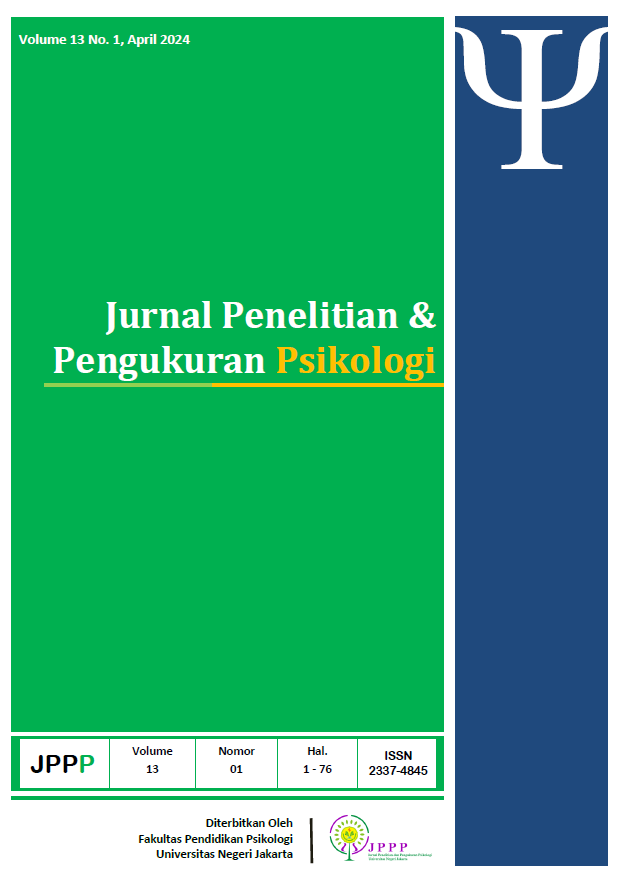Development of a Short Version of The Cyberchondria Scale
DOI:
https://doi.org/10.21009/JPPP.131.05Keywords:
cyberchondria, exploratory factor analysis, confirmatory factor analysisAbstract
This study aims to develop and validate a short version of the Cyberchondria Severity Scale (CSS). Exploratory Factor Analysis (EFA) was employed to identify the factor structure of the cyberchondria scale. The initial assumption tests indicated the scale's suitability for factor analysis (KMO > 0.5;
References
Aiken, M., Kirwan, G., Berry, M., & O’Boyle, C. A. (2012). The age of cyberchondria. Royal College of Surgeons in Ireland Student Medical Journal, 5, 71–74.
Aulia, A., Marchira, C. R., Supriyanto, I., & Pratiti, B. (2020). Cyberchondria in first year medical students of Yogyakarta. Journal of Consumer Health on the Internet, 24(1), 1–9. https://doi.org/10.1080/15398285.2019.1710096
Bessiere, K., Pressman, S., Kiesler, S., & Kraut, R. (2010). Effects of internet use on health and depression: A longitudinal study. Journal of Medical Internet Research, 12(1). https://doi.org/10.2196/jmir.1149
Cangur, S., & Ercan, I. (2015). Comparison of model fit indices used in structural equation modeling under multivariate normality. Journal of Modern Applied Statistical Methods, 14(1), 152–167. https://doi.org/10.22237/jmasm/1430453580
Edwards, P. J., Clarke, M. J., Roberts, I., DiGuiseppi, C., Wentz, R., Kwan, I., Cooper, R., Felix, L. M., & Pratap, S. (2009). Methods to increase response to postal and electronic questionnaires (Review). The Cochrane Library, 3(3). https://doi.org/10.1002/14651858.MR000008.pub4.www.cochranelibrary.com
Gray, N. J., Klein, J. D., Noyce, P. R., Sesselberg, T. S., & Cantrill, J. A. (2005). Health information-seeking behaviour in adolescence: The place of the internet. Social Science & Medicine, 60(7), 1467–1478. https://doi.org/10.1016/J.SOCSCIMED.2004.08.010
Huberty, J., Dinkel, D., Beets, M. W., & Coleman, J. (2013). Describing the use of the internet for health, physical activity, and nutrition information in pregnant women. Maternal and Child Health Journal, 17(8), 1363–1372. https://doi.org/10.1007/s10995-012-1160-2
Lauckner, C., & Hsieh, G. (2013). The presentation of health-related search results and its impact on negative emotional outcomes. Proceedings of the SIGCHI Conference on Human Factors in Computing Systems, 333–342. https://doi.org/10.1145/2470654.2470702
McElroy, E., & Shevlin, M. (2013). The development and initial validation of the cyberchondria severity scale (CSS). Journal of Anxiety Disorders, 28(2), 259–265. https://doi.org/10.1016/j.janxdis.2013.12.007
Muse, K., McManus, F., Leung, C., Meghreblian, B., & Williams, J. M. G. (2012). Cyberchondriasis: Fact or fiction? A preliminary examination of the relationship between health anxiety and searching for health information on the Internet. Journal of Anxiety Disorders, 26(1), 189–196. https://doi.org/10.1016/j.janxdis.2011.11.005
Schumacker, R. E., & Lomax, R. G. (2010). A Beginner’s Guide to Structural Equation Modeling. Routledge.
Singh, K., Fox, J. R. E., & Brown, R. J. (2016). Health anxiety and internet use: A thematic analysis. Cyberpsychology, 10(2). https://doi.org/10.5817/CP2016-2-4
Starcevic, V. (2017). Cyberchondria: Challenges of problematic online searches for health-related information. Psychotherapy and Psychosomatics, 86(3), 129–133. https://doi.org/10.1159/000465525
White, R. W., & Horvitz, E. (2009a). Cyberchondria: Studies of the escalation of medical concerns in Web search. ACM Transactions on Information, 27(23). https://doi.org/10.1145/1629096.1629101
White, R. W., & Horvitz, E. (2009b). Experiences with Web search on medical concerns and self diagnosis. AMIA ... Annual Symposium Proceedings, 696–700.
White, R. W., & Horvitz, E. (2010). Web to world: Predicting transitions from self-diagnosis to the pursuit of local medical assistance in Web search. AMIA ... Annual Symposium Proceedings, 882–886.
Aulia, A., Marchira, C. R., Supriyanto, I., & Pratiti, B. (2020). Cyberchondria in first year medical students of Yogyakarta. Journal of Consumer Health on the Internet, 24(1), 1–9. https://doi.org/10.1080/15398285.2019.1710096
Bessiere, K., Pressman, S., Kiesler, S., & Kraut, R. (2010). Effects of internet use on health and depression: A longitudinal study. Journal of Medical Internet Research, 12(1). https://doi.org/10.2196/jmir.1149
Cangur, S., & Ercan, I. (2015). Comparison of model fit indices used in structural equation modeling under multivariate normality. Journal of Modern Applied Statistical Methods, 14(1), 152–167. https://doi.org/10.22237/jmasm/1430453580
Edwards, P. J., Clarke, M. J., Roberts, I., DiGuiseppi, C., Wentz, R., Kwan, I., Cooper, R., Felix, L. M., & Pratap, S. (2009). Methods to increase response to postal and electronic questionnaires (Review). The Cochrane Library, 3(3). https://doi.org/10.1002/14651858.MR000008.pub4.www.cochranelibrary.com
Gray, N. J., Klein, J. D., Noyce, P. R., Sesselberg, T. S., & Cantrill, J. A. (2005). Health information-seeking behaviour in adolescence: The place of the internet. Social Science & Medicine, 60(7), 1467–1478. https://doi.org/10.1016/J.SOCSCIMED.2004.08.010
Huberty, J., Dinkel, D., Beets, M. W., & Coleman, J. (2013). Describing the use of the internet for health, physical activity, and nutrition information in pregnant women. Maternal and Child Health Journal, 17(8), 1363–1372. https://doi.org/10.1007/s10995-012-1160-2
Lauckner, C., & Hsieh, G. (2013). The presentation of health-related search results and its impact on negative emotional outcomes. Proceedings of the SIGCHI Conference on Human Factors in Computing Systems, 333–342. https://doi.org/10.1145/2470654.2470702
McElroy, E., & Shevlin, M. (2013). The development and initial validation of the cyberchondria severity scale (CSS). Journal of Anxiety Disorders, 28(2), 259–265. https://doi.org/10.1016/j.janxdis.2013.12.007
Muse, K., McManus, F., Leung, C., Meghreblian, B., & Williams, J. M. G. (2012). Cyberchondriasis: Fact or fiction? A preliminary examination of the relationship between health anxiety and searching for health information on the Internet. Journal of Anxiety Disorders, 26(1), 189–196. https://doi.org/10.1016/j.janxdis.2011.11.005
Schumacker, R. E., & Lomax, R. G. (2010). A Beginner’s Guide to Structural Equation Modeling. Routledge.
Singh, K., Fox, J. R. E., & Brown, R. J. (2016). Health anxiety and internet use: A thematic analysis. Cyberpsychology, 10(2). https://doi.org/10.5817/CP2016-2-4
Starcevic, V. (2017). Cyberchondria: Challenges of problematic online searches for health-related information. Psychotherapy and Psychosomatics, 86(3), 129–133. https://doi.org/10.1159/000465525
White, R. W., & Horvitz, E. (2009a). Cyberchondria: Studies of the escalation of medical concerns in Web search. ACM Transactions on Information, 27(23). https://doi.org/10.1145/1629096.1629101
White, R. W., & Horvitz, E. (2009b). Experiences with Web search on medical concerns and self diagnosis. AMIA ... Annual Symposium Proceedings, 696–700.
White, R. W., & Horvitz, E. (2010). Web to world: Predicting transitions from self-diagnosis to the pursuit of local medical assistance in Web search. AMIA ... Annual Symposium Proceedings, 882–886.
Downloads
Published
2024-04-30
Issue
Section
Articles







